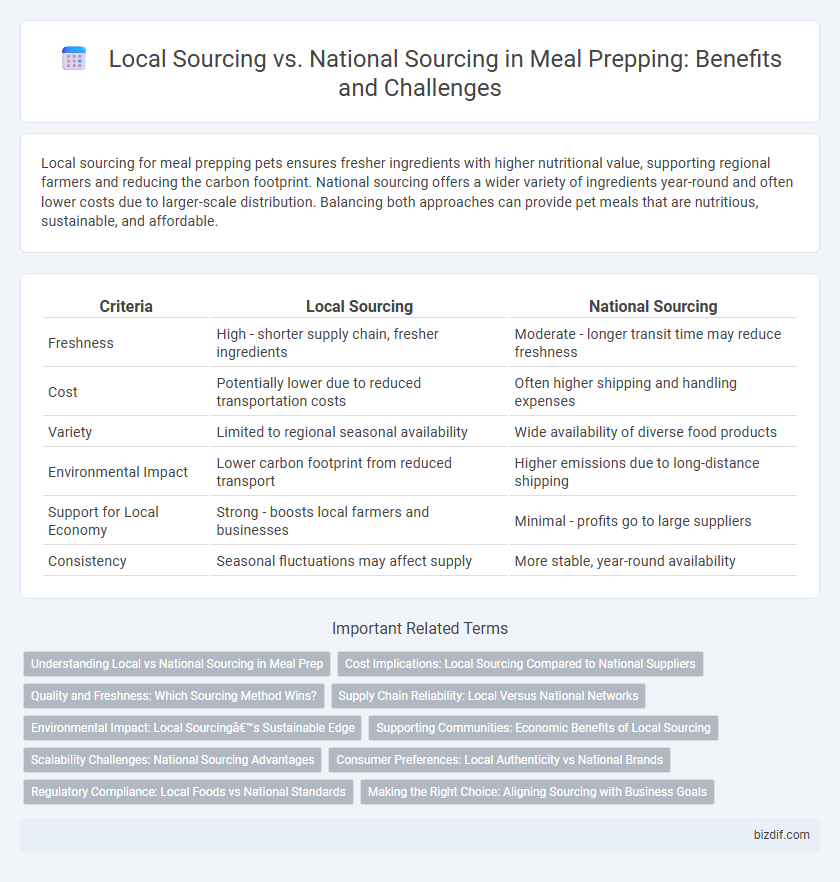Local sourcing for meal prepping pets ensures fresher ingredients with higher nutritional value, supporting regional farmers and reducing the carbon footprint. National sourcing offers a wider variety of ingredients year-round and often lower costs due to larger-scale distribution. Balancing both approaches can provide pet meals that are nutritious, sustainable, and affordable.
Table of Comparison
| Criteria | Local Sourcing | National Sourcing |
|---|---|---|
| Freshness | High - shorter supply chain, fresher ingredients | Moderate - longer transit time may reduce freshness |
| Cost | Potentially lower due to reduced transportation costs | Often higher shipping and handling expenses |
| Variety | Limited to regional seasonal availability | Wide availability of diverse food products |
| Environmental Impact | Lower carbon footprint from reduced transport | Higher emissions due to long-distance shipping |
| Support for Local Economy | Strong - boosts local farmers and businesses | Minimal - profits go to large suppliers |
| Consistency | Seasonal fluctuations may affect supply | More stable, year-round availability |
Understanding Local vs National Sourcing in Meal Prep
Local sourcing in meal prepping ensures fresher ingredients, supports regional farmers, and reduces carbon footprint, enhancing both taste and sustainability. National sourcing offers broader variety and consistent availability of ingredients regardless of season or region, aiding large-scale meal prep operations. Evaluating the trade-offs between local freshness and national consistency helps optimize meal prep efficiency and nutritional quality.
Cost Implications: Local Sourcing Compared to National Suppliers
Local sourcing for meal prepping often results in lower transportation costs and fresher ingredients, which can reduce spoilage and waste. National suppliers may offer bulk pricing that lowers per-unit costs but incur higher logistics expenses, increasing overall costs. Evaluating the trade-off between freshness and transportation fees is crucial for cost-effective meal prep operations.
Quality and Freshness: Which Sourcing Method Wins?
Local sourcing often delivers superior quality and freshness in meal prepping by reducing the time between harvest and consumption, ensuring ingredients retain peak flavor and nutritional value. National sourcing, while offering a broader variety of products, may involve longer transportation times that can compromise freshness and lead to higher risk of spoilage. For meal preppers prioritizing fresh and high-quality meals, local sourcing is generally the preferred method to maximize flavor and nutrient content.
Supply Chain Reliability: Local Versus National Networks
Local sourcing in meal prepping ensures fresher ingredients with shorter supply chains, reducing the risk of delays and disruptions common in national networks. National sourcing offers broader availability but often faces challenges from longer transit times and higher dependency on complex logistics. Prioritizing local suppliers enhances supply chain reliability by minimizing transportation bottlenecks and supporting consistent product quality.
Environmental Impact: Local Sourcing’s Sustainable Edge
Local sourcing significantly reduces carbon emissions by minimizing transportation distances, lowering fuel consumption and air pollution compared to national sourcing. Utilizing locally grown ingredients supports regional biodiversity and reduces the need for extensive packaging, which further decreases environmental waste. This sustainable edge makes local sourcing a preferred choice for eco-conscious meal prepping strategies.
Supporting Communities: Economic Benefits of Local Sourcing
Local sourcing for meal prepping significantly boosts regional economies by creating jobs and supporting small-scale farmers and producers. Purchasing ingredients locally reduces transportation costs, ensuring fresher products while funneling money directly back into community businesses. National sourcing often benefits large corporations, whereas local sourcing strengthens economic resilience and promotes sustainable development within the community.
Scalability Challenges: National Sourcing Advantages
National sourcing offers scalability advantages for meal prepping by enabling access to a broader range of suppliers and consistent ingredient availability across regions. It supports large-scale operations with streamlined logistics, reducing dependency on localized seasonal fluctuations that often limit local sourcing. This approach facilitates volume discounts and standardized quality, making it ideal for expanding meal prep businesses aiming to serve diverse markets efficiently.
Consumer Preferences: Local Authenticity vs National Brands
Consumers increasingly prioritize local sourcing for meal prepping due to its perceived freshness, authenticity, and support of local economies. Local ingredients often provide unique flavors and a sense of community connection that national brands may lack. However, national brands offer consistent quality, broader availability, and convenience that appeal to time-sensitive meal preppers.
Regulatory Compliance: Local Foods vs National Standards
Local sourcing of ingredients in meal prepping ensures adherence to region-specific regulatory compliance, often resulting in fresher produce with traceable origins and reduced transportation risks. National sourcing complies with broader federal food safety standards and labeling regulations, providing a consistent quality benchmark but sometimes at the expense of localized freshness. Balancing local and national standards requires meal preppers to navigate varying inspection protocols and certification requirements to maintain both safety and quality.
Making the Right Choice: Aligning Sourcing with Business Goals
Choosing between local and national sourcing for meal prepping depends on aligning supply chain decisions with business goals such as cost efficiency, sustainability, and customer preferences. Local sourcing supports freshness and community engagement, enhancing brand appeal for health-conscious consumers, while national sourcing offers broader product variety and scalability for higher-volume operations. Evaluating factors like lead time, ingredient quality, and environmental impact ensures the sourcing strategy complements operational priorities and market positioning.
Local sourcing vs national sourcing Infographic

 bizdif.com
bizdif.com